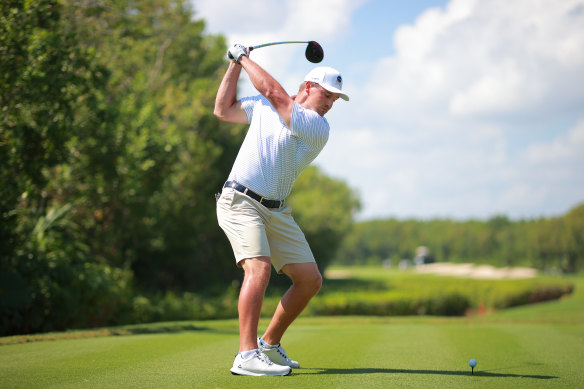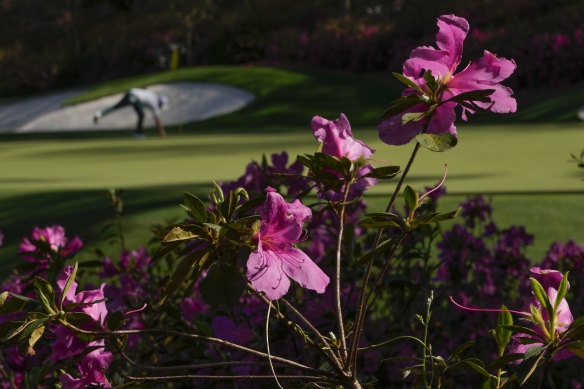This was published 1 year ago
Why golf is moving to stop elite players hitting the ball so far
By Alan Blinder
Elite golfers, who have increasingly used head-turning distances on their drives to conquer courses, should be forced to start using new balls within three years, the sport’s top regulators said Tuesday, inflaming a debate that has been gathering force in recent decades.
The US Golf Association and the R&A, which together write golf’s rule book, estimated that their technical proposal could trim top golfers’ tee shots by an average of about 15 yards. Although golf’s rules usually apply broadly, the governing bodies are pursuing the change in a way that makes it improbable that it will affect recreational golfers, whose talent and power are generally well outpaced by many collegiate and top amateur players.
But the measure, which would generally ban balls that travel more than 317 yards when struck at 204km/h, among other testing conditions, could have far-reaching consequences on the men’s professional game. Dozens of balls that are currently used could become illegal on circuits such as the PGA Tour and the DP World Tour, as the European Tour is now marketed, if they ultimately embrace the proposed policy change.
That outcome is not guaranteed — on Tuesday, the PGA Tour stopped well short of a formal endorsement of the proposal — but the forces behind the recommendation insisted that the golf industry needed to act.
“I believe very strongly that doing nothing is not an option,” Martin Slumbers, CEO of the R&A, said in an interview. “We want the game to be more athletic. We want it to be more of an elite sport. I think it’s terrific that top players are stronger, better trained, more physically capable, so doing nothing is something that to me would be, if I was really honest, completely irresponsible for the future of the game.”
The USGA’s CEO, Mike Whan, sounded a similar note in a statement: “Predictable, continued increases will become a significant issue for the next generation if not addressed soon.”

Rory McIlroy leads the PGA Tour for driving distance, averaging 327 yards off the tee.Credit: Getty
In the 2003 season, PGA Tour players recorded an average driving distance of about 286 yards, with nine golfers typically hitting at least 300 yards off the tee. In the current season, drives are averaging 297.2 yards, and 83 players’ averages exceed 300 yards. The typical club head speed — how fast the club is travelling when it connects with the ball — for Rory McIlroy, the tour’s current driving distance leader at almost 327 yards, has been about 196km/h, just over 11km/h above this season’s tour average. Some of his counterparts, though, have logged speeds of at least 210km/h.
At the sport’s most recent major tournament, the British Open last July, every player who made the cut had an average driving distance of at least 299.8 yards on the Old Course in St. Andrews, Scotland. When the Open, an R&A-administered tournament, had last been played at St. Andrews in 2015, only 29 of the 80 men who played on the weekend met that threshold.
The years-long escalation, spurred by advanced equipment and an intensifying focus among professional players on physical fitness, has unnerved the sport’s executives and course architects, who have found themselves redesigning holes while also sometimes fretting over the game’s potential environmental consequences.
When the Masters Tournament is contested at Augusta National Golf Club in Georgia next month, for instance, the par-5 13th hole will be 35 yards longer than it was last year. The hole, lined with azaleas and historically the course’s easiest, will now measure 545 yards; the full course will run 7545 yards, up 110 yards from a decade ago.

Bulked-up 2020 US Open winner Bryson DeChambeau headlines a new generation of golfers increasingly focusing on physical fitness.Credit: Getty
Faced with the distance scourge well beyond Augusta, golf’s rulemakers considered a policy targeting club design. They concluded, though, that such a reworked standard would cause too many ripples, with multiple clubs potentially requiring changes if drivers had to conform to new guidelines.
“If you don’t, you’ll end up with a three wood that could go further than a driver, and that was a very good point, and that could have affected three or four clubs in the bag,” Slumbers said. Instead, after years of study and debate, the USGA and R&A settled on trying to urge changes to the balls that players hit.
The rules currently permit balls that travel 317 yards, with a tolerance of an additional three yards, when they are struck at 193km/h, among other testing conditions. The existing formula has been in place since 2004, and Whan has said it is not “representative of today’s game.”
The proposal announced Tuesday is not final, and its authors will gather feedback about it into the summer. Although some members of the game’s old guard have openly complained about modern equipment and the governing bodies’ response to it — nine-time major champion Gary Player fumed last year that “our leaders have allowed the ball to go too far” and predicted top players would drive balls 500 yards within 40 years — the executives are bracing for resistance that could prove pointed.

The iconic 13th hole at Augusta National will be 35 yards longer for next month’s Masters.Credit: AP
“We have spoken to a lot of players, and as you can imagine, half of the world doesn’t want to do anything and half of the world thinks we need to do more,” Slumbers said.
The PGA Tour, filled with figures who believe that fans are dazzled by gaudy statistics and remarkable displays of athleticism, did not immediately support the proposal. In a statement Tuesday, the tour said it would “continue our own extensive independent analysis of the topic” and eventually submit feedback.
The tour added that it was “committed to ensuring any future solutions identified benefit the game as a whole, without negatively impacting the tour, its fans or our fans’ enjoyment of our sport.”
The debate may be more muted in some quarters than others, but the surges in distance have not been confined to the PGA Tour. Between 2003 and 2022, the R&A and the USGA said Tuesday, there was a 4 per cent increase in hitting distances across seven professional tours. Only two of the scrutinised circuits, the Japan Golf Tour and the LPGA Tour, posted year-over-year declines in driving distance in 2022.
This article originally appeared in The New York Times.
Sports news, results and expert commentary. Sign up for our Sport newsletter.